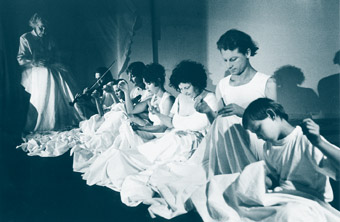Igneous: hands on diversity
Eleanor Brickhill

Igneous, The Hands Project
An obvious thing about people is that over time they change. Babies not only grow bigger but they also develop; into children, then young adults, and then older ones. Hands grow: remember trying to put on your mother’s nail polish when you were 4, playing jacks as a 10 year old, or the calluses which grew on your fingertips when you first started playing guitar? What about the feel of silk, the touch of lover, a slap in the face? Hands do more things now than they did 100 years ago, do things differently in this country than in others less computerised. People do not wave their hands about quite so much here, or get them callused in quite the same way. Children use finely tuned motor skills for playing tiny computer games, instead of larger muscle groups for more expansive activities.
One impetus that Suzon Fuks and James Cunningham have had, as artistic directors of The Hands Project, is the idea that groups of performers and audiences alike tend to be rather homogenous and don’t properly reflect real human difference. The Hands Project offers a cast widely differing in age, background and capacity, a profusion of ideas, a tumble of images reflecting, above all, human diversity as expressed through the hands: from the fine needlecraft of an elderly woman embroidering to a baby’s tenacious grip; from the particular expertise of an able-bodied dancer to the manifold dexterity of a one armed/legged woman; from the clinical slap and scrutiny of a researcher to a lover’s lingering caress.
It’s likely that this profusion creates both richness and difficulty for the audience, who need to constantly change their focus and position in the space, simultaneously avoiding members of the cast and each other, and mobile slide projectors, while keeping track of a complex stream of images created by soundscape, lighting, slide and video projections and live performance, much of which might occur simultaneously in different rooms. The spaces between bodies (yours, 2 lovers on a bed, little boys chasing each other brandishing prosthetic arms like swords) and images (a moving car, looming silhouettes, a baby’s hand too large for comfort) start to narrow and fill with noise, until you realise that this is a microcosm, a day in the life of…, a street full of apartments with no facades, rooms with people sleeping, working, playing, in pain and in love, simply living, touching and holding onto things with a sliding scale of intensity and purpose and a variety of grips.
Some of the ideas work better than others. There are the ‘researchers’ with white lab coats, clipboards and severe demeanour, who create an unintentional but pervasive atmosphere of ominous disquiet throughout the piece. They might have been mad doctors wielding mind-altering drugs to helpless inmates, but they seem definitely in control, directing our attention one way or another as they silently observe and take notes. The best images are often quite simple: an Alice-in-Wonderland illusion is created when a dancer (Eddie Kay) enters onto a doll-sized raised platform through a small, half-concealed doorway behind it. This corner is constructed to create a false perspective against which another film image of a woman is projected. She seems to inhabit the space, walking in and out, as if 3-dimensional. Later in the work, a young boy begins a vividly eloquent sequence where he is palpably being tickled; we can feel and see his helpless giggling, mounting hysteria, and then the sudden crossing of some invisible line where helplessness turns into serious anger and retaliation.
The Hands Project, its Sydney showing a further incarnation of work first presented in October 1999 in Lismore, is indeed a ‘work in progress’, and it’s conceivable that it might stay this way for a while longer, as the material which Igneous is attempting to embrace seems potentially infinite. While the human body itself draws our attention to its own condition, our hands are often our most eloquent communicators and agents for change, without which we are still in many ways mute.
The Hands Project, Igneous, Centre for Performance Studies, University of Sydney, Jan 26-28.
RealTime issue #41 Feb-March 2001 pg. 27






